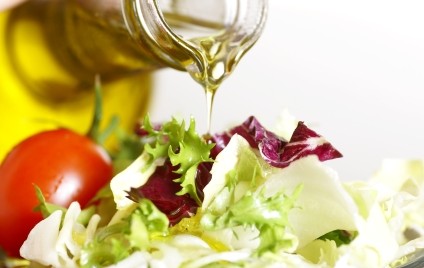Oils… There are so many now on the market that it can be very confusing when choosing which one to buy. Nutritionist Megan Crockart explains some of the common oils.
We do need some fat in our diet. Fats are considered saturated, mono-unsaturated, poly-unsaturated and trans fatty acids. Trans fats should be completely avoided as they can be a synthetic fat (only animal products contain natural trans fats) that impacts on cholesterol similar to saturated fats. When it comes to oils, always try to get unrefined, cold pressed versions as they contain the most nutrients and health benefits.
Olive oil is generally considered one of the best oils for cooking as well as salad dressings and for use on the skin. It has been used for thousands of years in the western world and has shown many health benefits. Try to ensure you get extra virgin olive oil as it contains the most nutrition and flavour. Most other types of olive oil (they range from “pure”, “light” and “virgin”) are refined usually through chemical solvent extraction with a little bit of extra virgin olive oil added for flavour.
Sunflower Oil and Safflower Oil should both be oleic-rich versions to make these unstable polyunsaturated oils more stable unrefined monounsaturates. If using a non-oleic rich sunflower or safflower oil, then ensure it is cold pressed and only use for food preparation and not cooking with heat.
Canola Oil could have some health benefits being a monounsaturated fat but the downside to Canola is it was originally engineered from rapeseed and now most canola is genetically modified, even in Australia! Also its hard to find an unrefined canola oil (which contains healthful nutrients) and if you do find one, most people can’t tolerate the bitter flavour the unrefined version has.
Peanut oil/sesame oil have been around for thousands of years in Asia and both have varying health benefits. Peanut oil is stable at high temperatures and has healing benefits – organic peanut oil should be sourced. Sesame oil can also be used at high temperatures in cooking, added to foods after cooking for extra flavour and also can be applied to dry, cracked skin and can help with relieving constipation.
Vegetable oil is often a blend of different oils usually canola but can also be the “bad” palm oil which has environmental impacts. Generally avoid vegetable oil as you can’t be sure what’s in it and generally it’s extremely refined.
Other oils which are good for salad dressings as they are polyunsaturated and should not be heated include flaxseed/linseed oil, chia oil and walnut oil.
Other oils great for cooking include avocado, macadamia and almond oils.
The smoke point of oils appears to be controversial with varying differences in how high you can heat an oil before it starts to smoke. The more refined the oil the higher the smoke point which also means these refined oils have less nutrition and undertake more processing. In particular olive oil has some differing of opinions when it comes to heating. Here is what the International Olive Oil Council says:
Olive oil is ideal for frying. In proper temperature conditions, without over-heating, it undergoes no substantial structural change and keeps its nutritional value better than other oils, not only because of the antioxidants but also due to its high levels of oleic acid. Its high smoking point (210 deg/C) is substantially higher than the ideal temperature for frying food (180 deg/C). Those fats with lower critical points, such as corn and butter, break down at this temperature and form toxic products.
http://www.internationaloliveoil.org/estaticos/view/85-frying-with-olive-oil
Below are the smoke points of these common oils compared with other fats
|
Oil/Fat |
Smoke Point – Degrees Celsius |
| Avocado | 216 |
| Sesame | 177 |
| Olive | 210 |
| Canola | 190-232 |
| Butter | 121-149 |
| Clarified butter/Ghee | 252 |
| Sunflower (oleic rich) | 160 |
| Safflower (oleic rich) | 107 |
| Almond | 216 |
| Coconut Oil | 177 |
| Flaxseed | 107 |
| Sesame | 177 |
| Peanut | 160 |
| Rice Bran | 213 |

